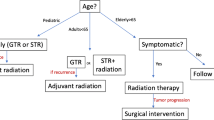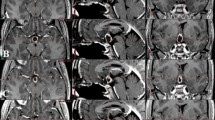Abstract
Craniopharyngiomas are benign suprasellar tumors that arise from epithelial remnants of the Rathke’s pouch. The two standard treatment options are primary total resection or limited surgery followed by external beam radiation. The 10- and 20-year progression-free survival rates following limited surgery and radiation therapy are superior to those achieved by primary surgery alone. The side effect profiles for these two treatment approaches are different. Following total resection there is a very high incidence of panhypopituitarism requiring lifelong multiple hormone replacement therapy. The other side effects include potential damage to adjacent structures such as optic chiasm, vasculature and hypothalamus. Following limited surgery and radiation therapy the incidence of endocrine deficits is significantly lower compared to radical surgery, as is the risk of neurovascular and hypothalamic injury. Optic neuropathy and brain necrosis are rare in modern radiation therapy series. Second malignant neoplasms, although rare, can occur. In children with recurrent craniopharyngiomas following radical surgery, the recommended salvage treatment is radiation therapy, as further surgical attempts at salvage are associated with high relapse rates and increased morbidity and mortality. There have been significant technological advances in the field of radiation treatment planning and delivery that have great potential for reducing the incidence of long-term irradiation sequelae in the developing brain. The general availability of megavoltage linear accelerators and modern radiotherapy innovations such as three-dimensional conformal radiation treatment (3D CRT), stereotactic radiosurgery (SRS), stereotactic radiotherapy (SRT), and intensity modulated radiation therapy (IMRT) should further limit the rate of complications and improve cure rates in children with primary or recurrent craniopharyngioma.


Similar content being viewed by others
References
Amendola BE, Wolf A, Coy SR et al (2003) Role of radiosurgery in craniopharyngiomas: a preliminary report. Med Pediatr Oncol 41:123–127
Austin-Seymour M, Munzenrider J, Linggood R et al (1990) Fractionated proton radiation therapy of cranial and intracranial tumors. Am J Clin Oncol 13(4):327–330
Baumert BG, Norton IA, Lomax AJ et al (2004) Dose conformation of intensity-modulated stereotactic photon beams, proton beams and intensity-modulated proton beams for intracranial lesions. Int J Radiat Oncol Biol Phys 60(4):1314–1324
Berge VJH, Blaauw G, Breeman WA et al (1992) Intracavitary brachytherapy of cystic craniopharyngiomas. J Neurosurg 77:545–550
Bitzer M, Topka H (1995) Progressive cerebral occlusive disease after radiation therapy. Stroke 26(1):131–136
Bloom HJG, Glees J, Bell J (1990) The treatment and long-term prognosis of children with intracranial tumors: a study of 610 cases 1950–1981. Int J Radiat Oncol Biol Phys 18:723–745
Brada M, Ford D, Ashley S et al (1992) Risk of second brain tumor following conservative surgery and radiotherapy of pituitary adenoma. Br Med J 304:1343–1346
Buatti JM, Bova FJ, Friedman WA et al (1998) Preliminary experience with frameless stereotactic radiotherapy. Int J Radiat Oncol Biol Phys 42(3):591–599
Carpenter RC, Chamberlin GW, Frazier CH (1937) The treatment of hypophyseal stalk tumors by evacuation and irradiation. Am J Roentgenol 38:162–177
Cavazzuti V, Fischer EG, Welch K et al (1983) Neurological and psychophysiological sequelae following different treatments of craniopharyngioma in children. J Neurosurg 59:409–417
Chang SX, Cullip TJ, Deschesne KM (2000) Intensity modulation delivery techniques: “Step and shoot” MLC auto-sequence versus the use of a modulator. Med Phys 27:948–959
Chiou SM, Lunsford LD, Niranjan A et al (2001) Stereotactic radiosurgery of residual or recurrent craniopharyngioma, after surgery, with or without radiation therapy. Neuro-Oncol 3:159–166
Chung WY, Pan DHC, Shiau CY et al (2000) Gamma knife radiosurgery for craniopharyngiomas. J Neurosurg 93(3):47–56
De Vile CJ, Grant DB, Hayward RD et al (1996) Obesity in childhood craniopharyngioma: relation to post-operative hypothalamic damage shown by magnetic resonance imaging. J Clin Endocrinol 81:2734–2737
Muller HL, Emser A, Faldum A, Bruhnken G, Etavard-Gorris N, Gebhardt U, Oeverink R, Kolb R, Sorensen N (2004) Longitudinal study on growth and body mass index before and after diagnosis of childhood craniopharyngioma. J Clin Endocrinol Metab 89(7):3298–3305
DeVile CJ, Grant DB, Hayward RD et al (1996) Growth and endocrine sequelae of craniopharyngioma. Arch Dis Child 75:108–114
Ellenberg L, McComb JG, Sieger S et al (1987) Factors affecting intellectual outcome in pediatric brain tumor patients. Neurosurgery 21(5):638–644
Fischer EG, Welch K, Shillito J et al (1990) Craniopharyngiomas in children. Long term effects of conservative surgical procedures combined with radiation therapy. J Neurosurg 73:534–540
Fisher PG, Jenab J, Gopldthwaite PT et al (1998) Outcomes and failure patterns in childhood craniopharyngiomas. Childs Nerv Syst 14(10):558–563
Flickinger JC, Lunsford LD, Singer J et al (1990) Megavoltage external beam irradiation of craniopharyngiomas: analysis of tumor control and morbidity. Int J Radiat Oncol Biol Phys 19(1):117–122
Freeman CR (2003) Correspondence: highly conformal radiotherapy for craniopharyngioma: (potentially) throwing the baby out with the bathwater. Med Pediatr Oncol 40:340–341
Habrand JL, Ganry O, Couanet D et al (1999) The role of radiation therapy in the management of craniopharyngioma: a 25 yr. experience and review of literature. Int J Radiat Oncol Biol Phys 44(2):255–263
Harris JR, Levene MB (1976) Visual complications following irradiation for pituitary adenomas and craniopharyngiomas. Radiology 120(1):167–171
Hasegawa T, Kondziolka D, Hadjipanayis CG et al (2004) Management of cystic craniopharyngiomas with phosphorus-32 intracavitary irradiation. Neurosurgery 54(4):813–822
Hetelekidis S, Barnes PD, Tao ML et al (1993) 20 yr. experience in childhood craniopharyngioma. Int J Radiat Oncol Biol Phys 27(2):189–195
Hoffman HJ, Da Silva M, Humphreys RP et al (1992) Aggressive surgical management of craniopharyngiomas in children. J Neurosurg 76:47–52
Huang E, The BS, Strother DR et al (2002) Intensity modulated radiation therapy for pediatric medulloblastoma: early report on the reduction of ototoxicity. Int J Radiat Oncol Biol Phys 52(3):559–605
Ishikawa T, Houkin K, Yoshimoto T et al (1997) Vasoreconstructive surgery for radiation induced vasculopathy in childhood. Surg Neurol 48(6):620–626
Jose CC, Rajan B, Ashley S et al (1992) Radiotherapy for the treatment of recurrent craniopharyngioma. Clin Oncol 4(5):287–289
Kalapurakal JA, Goldman S, Hsieh YC et al (2003) Clinical outcome in children with craniopharyngioma treated with primary surgery and radiotherapy deferred until relapse. Med Pediatr Oncol 40:214–218
Kalapurakal JA, Goldman S, Hsieh YC et al (2000) Clinical outcome in children with recurrent craniopharyngioma after primary surgery. Cancer J 6:388–393
Kalapurakal JA, Kepka A, Bista T et al (2000) Fractionated stereotactic radiotherapy for pediatric brain tumors: the Chicago children’s experience. Childs Nerv Syst 16:296–302
Kalapurakal JA, Ilahi Z, Kepka AG et al (2001) Repositioning accuracy with the Laitinen frame for fractionated stereotactic radiation therapy in adult and pediatric brain tumors: preliminary report. Radiology 218:157–161
Kao GD, Goldwein J, Radcliffe J et al (1992) The impact of multiple post-operative factors on neurocognitive function in children treated with radiation therapy for medulloblastomas. Int J Radiat Oncol Biol Phys 24(1):226–231
Kitanaka C, Shitara N, Nakagomi T et al (1989) Postradiation astrocytoma. Report of two cases. J Neurosurg 70(3):469–474
Kobayashi T, Tanaka T, Kida Y(1994) Stereotactic gamma radiosurgery of craniopharyngiomas. Pediatr Neurosurg 21(1):69–74
Kooy HM, Dunbar SF, Tarbell NJ et al (1994) Adaptation and verification of the relocatable Gill–Thomas–Cosman frame in stereotactic radiotherapy. Int J Radiat Oncol Biol Phys 30:685–691
Kortmann RD, Becker G, Perelmouter J et al (1999) Geometric accuracy of field alignment in fractionated stereotactic conformal radiotherapy of brain tumors. Int J Radiat Oncol Biol Phys 43(4):921–926
Kramer S, Southoral M, Mansfield CM (1968) Radiotherapy in the management of craniopharyngiomas: further experience and late results. Am J Roentgenol 103:44–52
Loeffler JS, Kooy HM, Tarbell NJ (1999) The emergence of conformal radiotherapy: special implications for pediatric neuro-oncology. Int J Radiat Oncol Biol Phys 44(2):237–238
Merchant TE, Kiehna EN, Sanford RA et al (2002) Craniopharyngioma: the St. Jude children’s research hospital experience 1984–2001. Int J Radiat Oncol Biol Phys 53(3):533–542
Mori K, Takeuchi J, Ishikawa M et al (1978) Occlusive arteriopathy and brain tumor. J Neurosurg 49:22–35
Palm L, Nordin D, Elmqvist D et al (1992) Sleep and wakefulness after treatment for craniopharyngioma: influence on the quality and maturation of sleep. Neuropediatrics 23:39–45
Pereira P, Cerejo A, Cruz J et al (2002) Intracranial aneurysm and vasculopathy after surgery and radiation therapy for craniopharyngioma: case report. Neurosurgery 50(4):885–888
Prasad D, Steiner M, Steiner L (1995) Gamma knife surgery for craniopharyngioma. Acta Neurochir 134:167–176
Rajan B, Ashley S, Gorman C et al (1993) Craniopharyngioma—a long term results following limited surgery and radiotherapy. Radiol Oncol 26(1):1–10
Rajan B, Ashley S, Thomas DG et al (1997) Craniopharyngioma: improving outcome by early recognition and treatment of acute complications. Int J Radiat Oncol Biol Phys 37(3):517–521
Regine WF, Kramer S (1992) Pediatric craniopharyngiomas: long-term results of combined treatment with surgery and radiation. Int J Radiat Oncol Biol Phys 24 (4):611–617
Russell DS, Rubinstein LJ (1989) Pathology of tumors of the nervous system, 5th edn. Williams and Wilkins, Baltimore, pp 695–702
Sanford RA (1994) Craniopharyngioma: results of survey of the American Society of Pediatric Neurosurgery. Pediatr Neurosurg 21(1):39–43
Schulz-Ertner D, Frank C, Herfarth KK et al (2002) Fractionated stereotactic radiotherapy for craniopharyngiomas. Int J Radiat Oncol Biol Phys 54(4):1114–1120
Sogg RL, Donaldson SS, Yorke CH (1978) Malignant astrocytoma following radiotherapy of a craniopharyngioma. Case report. J Neurosurg 48(4):622–627
Stripp DCH, Maity A, Janss AJ et al (2004) Surgery with or without radiation therapy in the management of craniopharyngiomas in children and young adults. Int J Radiat Oncol Biol Phys 58(3):714–720
St. Clair WH, Adams JA, Bues M et al (2004) Advantage of protons compared to conventional x-ray or IMRT in the treatment of a pediatric patient with medulloblastoma. Int J Radiat Oncol Biol Phys 58(3):727–734
Sung KI, Chang CH, Harisiadis L et al (1981) Treatment results of craniopharyngiomas. Cancer 47:847–852
Tarbell N, Scott RM, Goumnerova LC et al (1996) Craniopharyngioma: preliminary results of stereotactic radiation therapy. In: Kondziolka D (ed) Radiosurgery, vol 1. Karger, Basel, pp 75–82
Tishler RB, Loeffler JS, Lunsford LD et al (1993) Tolerance of cranial nerves of the cavernous sinus to radiosurgery. Int J Radiat Oncol 27(2):215–221
Ushio Y, Arita N, Yoshimine T et al (1987) Glioblastoma after radiotherapy for craniopharyngioma: case report. Neurosurgery 21(1):33–38
Voges J, Sturm V, Lehrke R et al (1997) Cystic craniopharyngioma: long-term results after intracavitary irradiation with stereotactically applied colloidal beta-emitting radioactive sources. Neurosurgery 40(2):263–270
Waga S, Handa H (1976) Radiation induced meningioma: with review of literature. Surg Neurol 5(4):215–219
Wara WM, Sneed PK, Larson DA (1994) The role of radiation therapy in the treatment of craniopharyngioma. Pediatr Neurosurg 21(1):98–100
Webb S (2003) The physical basis of IMRT and inverse planning. Br J Radiol 76:678–689
Weiner HL, Wisoff JH, Rosenberg ME et al (1994) Craniopharyngiomas: a clinicopathological analysis of factors predictive of recurrence and functional outcome. Neurosurgery 35(6):1001–1010
Weiss M, Sutton L, Marcial V et al (1989) The role of radiation therapy in the management of childhood craniopharyngioma. Int J Radiat Oncol Biol Phys 17(6):1313–1321
Wen BC, Hussey DH, Staples J et al (1989) A comparison of the roles of surgery and radiation therapy in the management of craniopharyngiomas. Int J Radiat Oncol Biol Phys 16(1):17–24
Yasargil MG, Curlic M, Kis M et al (1990) Total removal of craniopharyngiomas. Approaches and long-term results in 144 patients. J Neurosurg 73(1):3–11
Author information
Authors and Affiliations
Corresponding author
Rights and permissions
About this article
Cite this article
Kalapurakal, J.A. Radiation therapy in the management of pediatric craniopharyngiomas—a review. Childs Nerv Syst 21, 808–816 (2005). https://doi.org/10.1007/s00381-005-1188-3
Received:
Published:
Issue Date:
DOI: https://doi.org/10.1007/s00381-005-1188-3




